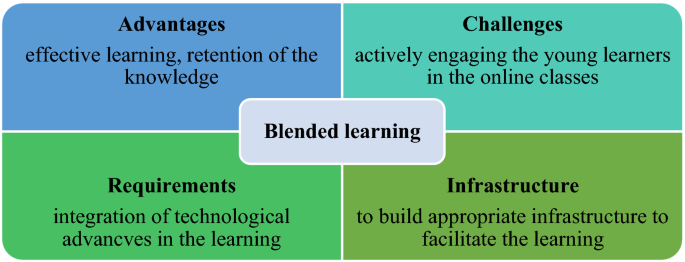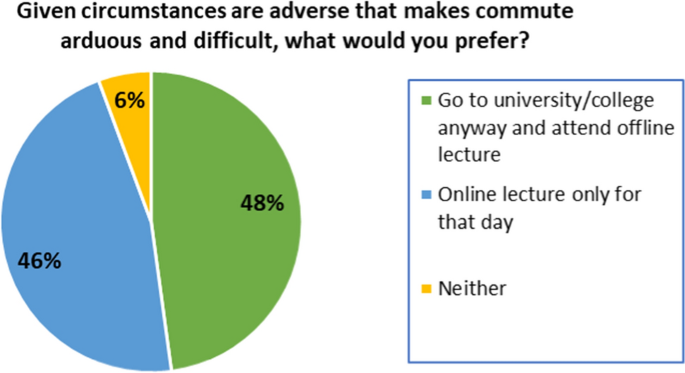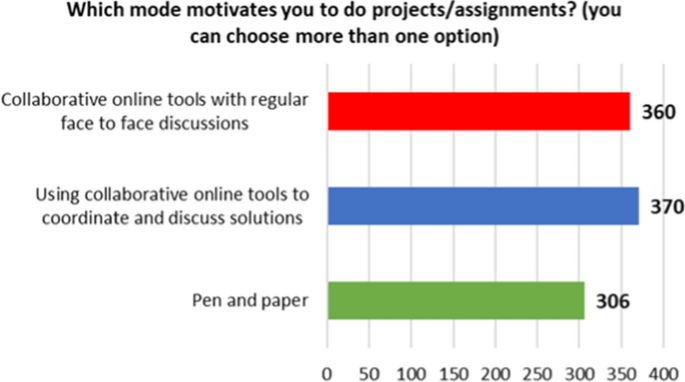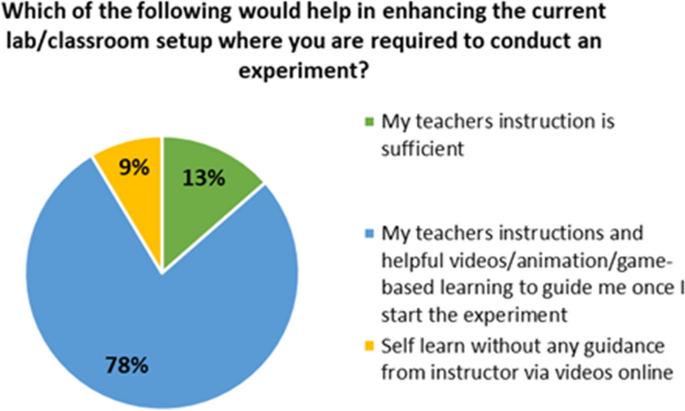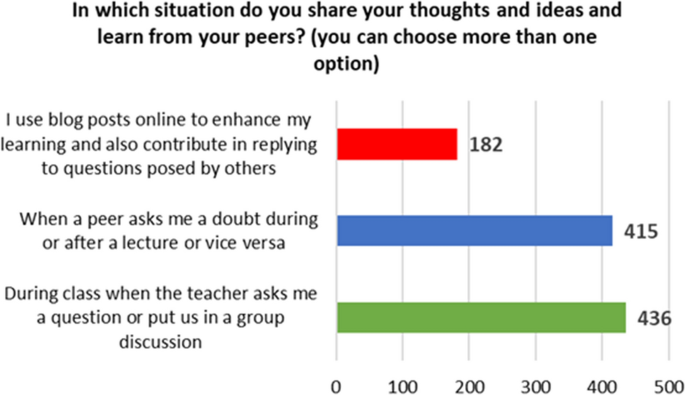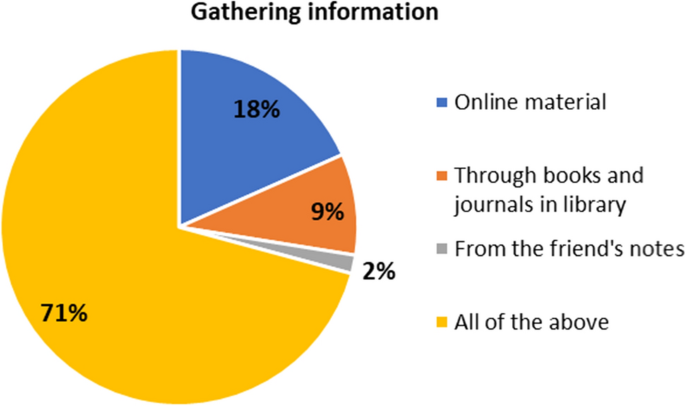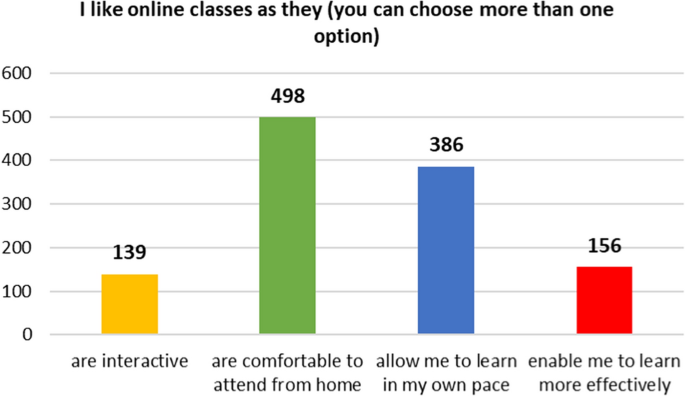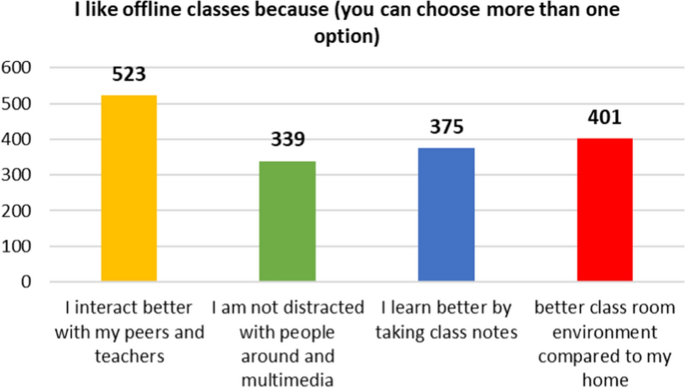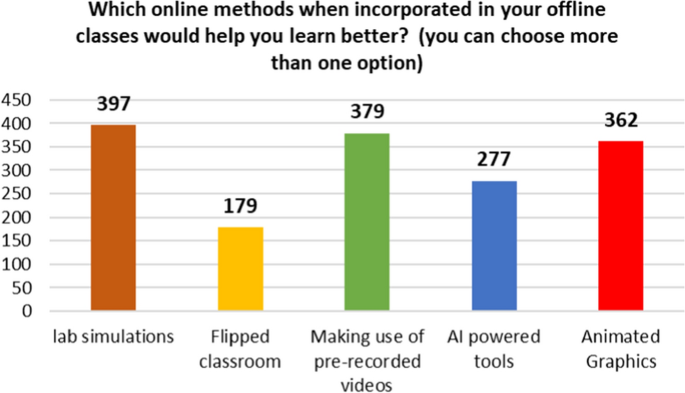Abstract
The education sector is witnessing a paradigm shift with the rapid and ongoing technological advancements. The online, offline, and blended modes of learning continue to evolve with time. The purpose of this survey is to collect students’ responses to understand their perspectives on the different modes of learning. The advantages, challenges, and requirements for conducting classes through online, offline, and blended learning methods are discussed. A questionnaire was designed, and a survey was conducted among undergraduate engineering students. The questions are carefully planned to understand the choice of students while selecting different modes of learning, various activities and tools, and the reasons for their preferences. 654 students took part in the survey and shared their feedback. The advantages and disadvantages of online and offline learning are presented. A chi-square test was conducted, and the association between the two questions is shown to be significant. Suggestions for enhancing teaching and learning based on the findings of the survey help faculty members to plan the teaching methodology to suit the requirements of students.
Avoid common mistakes on your manuscript.
Introduction
Learning is a dynamic phenomenon and it is evolved continually over the years. The effectiveness of learning depends on the methodology adopted. The methodology or the pedagogy depends on the skillsets that are expected to be acquired by the students. The COVID-19 pandemic has given an opportunity to experience and assess various online teaching and evaluation tools. In this the stake holders are students, teachers and institutional administrators. Chang et al. [1] had contrasted the physical classroom learning efficacy and online learning to estimate and enhance the quality of learning. Both the methods of learning were surveyed among the students, and results showed that the learning efficacy of online class learning was better than that of physical classroom learning. Survey results on the contrary indicated that the suitability and fairness of physical classroom evaluation were better than that of online examination. The students across various schools expressed their learning experiences during the COVID-19 pandemic period were to some extent effective and engaging. The study by Singh et al. emphasized the thrust to build an apt infrastructure and capacity building to support hybrid and blended learning methods. The capacity building also included familiarizing the faculty members with the various online learning methods and e-Learning tools. The study by Singh et al. suggested that both the learners and the teachers are to make use of the innovative technology to enable effective teaching and engaged learning [2]. Ghosh [3] presented an intelligent tutoring system (ITS) that behaves like a real teacher by having the dynamic response and dynamic review of the performance of students and their level of understanding. In the backdrop of COVID-19 and its multiple variants, the challenge was to design appropriate educational technologies to improve learning efficiency [4, 5]. Darius et al. [6] found that animations, digital collaborations with fellow students, video lectures delivered by the same faculty, online quizzes, student version software, online interaction with faculty, and online materials provided by the faculty promote effective online learning.
A study conducted by Michalíková and Povinský, Matej Bel University concluded that blended learning was one of the best ways of learning during this pandemic period [7]. The conclusions of a study conducted by Hysaj in Albania motivate the researchers to bring out more research on the employment of various technological tools to raise young learners' lively involvement in online learning [8]. Online learning tools provided a good learning space for learners to learn independently. Also, the proposed teaching model would enhance the students’ knowledge retention in comparison to traditional classroom learning. Hence, the proposed model proved to be feasible and effective although it requires necessary capacity-building measures in place, as shown in Fig. 1 [9,10,11]. In all the e-learning, hybrid learning, and blended learning strategies, interactions between students and teachers are vital apart from the appropriate online settings. Nortvig et al. indicated that the designed influences between online and offline activities as well as between campus-related and practice-related activities are crucial factors for effective learning [12].
This paper reports the outcome of a survey carried out among undergraduate students pursuing an engineering degree. The responses given by students are presented and discussed in the following sections. The comments and suggestions given in the last section are useful to faculty members in designing their teaching pedagogy to suit the requirements of students to improve the quality of teaching–learning.
Methodology
The parametric study was carried out to understand the advantages and disadvantages of the different modes of learning such as Online, Offline, and Blended. A questionnaire as shown in annexe-1 was developed by the authors, and it was used for conducting the survey. Questions 1–8 are used to know the students’ familiarity and inclination to use the different modes of learning. Questions 9–10 are related to know the various activities and tools, used by the students. Questions 11–14 are for knowing the reasons as to why students prefer one mode of learning to the other. The last section of the questionnaire is for the comments and suggestions by the students for improving the teaching and learning methods followed at present. The questionnaire was floated in the form of Google form and a total of 654 students from various universities pursuing BTech courses participated in this survey. The data analysis was done using Microsoft excel and SPSS software and Chi square method is used for checking the association between different questions. The participants belong to private universities, colleges, and institutions (VIT, BML Munjal University, and CMR Institute of Technology). 66% of the respondents are from Mechanical Engineering, 30% of them are from Computer Science Engineering, and the rest from other engineering branches. Students of the age group from 16 to 30 years took part in the survey. 54% are from the age group of 16–20, 45% are in the age group of 21–25 and only 1% are in the age group of 26–30. 83.9% of respondents are males, and 16.1% of respondents are females.
Results and Discussion
In an adverse situation, when commuting seems a problem, the majority of the students would still like to go to university to attend offline lectures. This shows their preference to attend offline lectures, though a lot of students would still prefer online lectures on such days. Some students could not give a concrete response. As per Fig. 2, 48% of students prefer offline lectures in adverse circumstances, 46% of students would like to attend online lectures and 6% of students seem indecisive. Offline classes open multiple avenues to meet and interact with new people. The strong urge to socialize with their peers to learn and explore things together always fascinates the students. Besides they can meet and discuss their academic and non-academic concerns with their teachers. Paul and Jefferson [13] stated Face to face classroom discussions address the important issues and provide instantaneous response which helps students to resolve their concerns. Overall, offline sessions stimulate class interactions and encourage students to become active participants in the learning process—A well-organized classroom accelerates the higher order thinking which can be very useful in pursuing research projects and other class assignments. Kemp and Grieve [14] stated, in offline mode the teachers can adapt and improvise their teaching style then and there to improve students' performance and participation.
Since the pandemic, the inclination to integrate technology in learning has become obvious amongst the students. As shown in Table 1, 39% agree that technology-driven learning is more user-friendly. 26% of students gave a neutral response 16% of students strongly agree with the statement. 13% of students disagree and 6% of students strongly disagree with the statement. Mayadas, et al. [15] suggested Digital learning is multifaceted and diverse. It is essential to clearly understand the meaning of e-Learning to reap its maximum benefits. Revised and improvised teaching pedagogies, incorporate technology to enrich the teaching learning experience and help both teachers and learners to become better equipped to face multiple learning challenges.
Miscellaneous modes of learning provide an opportunity for a facilitator to reach out to all the learners to identify their learning needs. This can be very useful to improve teaching pedagogies so that learning outcomes can be achieved. As shown in Table 1, the majority of the students- 50% agree that a multidimensional learning environment facilitates individualized learning by addressing the difficulties faced by learners with mixed ability levels. 26% strongly agree, 17% students neither agree nor disagree, 5% students disagree and 2% strongly disagree with the statement. Freitas et al. [16] stated that psychosocial needs of the students may affect their behaviour and academic performance. Each learner is different and at the same time unique in his/ her learning approach. Fixed and rigid pedagogies fail to leave a fulfilling and nurturing learning impacts. Rahman et al. [17] stated that learning satisfaction increases when teachers provide and create a conducive and learner friendly classroom. Combination of offline and online learning is flexible and to a large extent addresses the issues and challenges faced by different learners at different levels.
Different modes of learning have improvised teaching methodologies and tools which can be used to enhance the overall learning experience. Table 2 shows that the majority of the students, 68% prefer classroom learning along with notes and materials shared through ICT tools. This indicates that the notes and materials shared through ICT tools provided by the teacher are of immense help to the students as they may use them to further improve their understanding of concepts, whereas 25% of students prefer chalk and board with ICT tools such as PPTs and Smartboard. Only 7% of students prefer the chalk and board method. Kirkwood and Price [18] stated that technology enhanced education, comprises of digital tools and face to face interactions, raises the level of engagement and learning. Variety of face to face activities, research projects rightly blended with various ICT tools lead to experiential and competency-based learning. Watson [19] aptly stated that combination of face to face learning with e-Learning ameliorates the overall teaching learning experience.
Availability of various tools in different modes of the learning benefits the students. They have the option to choose the conducive modes/ tools to complete their assignments and projects. As shown in Fig. 3, the students are not stuck to one option. They explore the various available options. Broadly it can be seen that 370 students prefer using online collaborating tools. 360 students use collaborative tools with face-to-face discussions. 306 students prefer using pen and paper. Collaborating online tools with offline class activities boost the efficiency and understanding level of the students. They also help in reducing lecture time as sometimes long lectures with no activities might become monotonous. Integrating e-Learning with face to face learning promotes the critical thinking, collaborative learning, problem solving and strong interpersonal skills.
Communication plays a vital role in education. Honing the soft skills is essential for overall personality development. As per Table 3, the students have shown a strong inclination towards communicating in an offline manner with their teachers and peers. This states the importance of the offline mode of learning in improving communication skills. 58% of students prefer to meet peers and teachers offline for better interaction, 23% prefer online communication with their teachers and peers. 19% expressed that they did not experience a rich interaction with their teachers and peers during online classes. Face to face meetings and interactions lead to engaging and captivating discussions and provide opportunities to expand the thinking arena. Kee [20] mentioned that interaction is an essential aspect of learning. Most of the complex problems can be discussed and solved through face to face interactions. These interactions prove very useful for the students. Class interactions increase self-esteem, confidence, and engagement. They motivate students to think creatively and work independently. Those who consistently participate feel themselves as valuable members of the class.
Laboratories perform a crucial role in learning and concept building. The clear and coherent instructions always help students to carry out their laboratory activities. As shown in Fig. 4, 78% of students feel that teacher’s instructions and other aids such as videos/ animation/ games help in enhancing the laboratory setup. 13% of students feel that their teacher’s instructions are sufficient and 9% believe in self-learning and can manage their activities on their own. Laboratories help students to develop the aptitude of experimenting and checking things. Wollenberg and Mohan [21] stated Laboratories are one of the effective ways to see the practical utility of the theoretical concepts. Application of the theoretical concepts in the laboratories excites the students to test their knowledge. Doherty and Moorkens [22] stated Laboratories stimulate and help in develo** research temperament among the students. Various experiments and practical activities enable students to enhance technical proficiency.
Peer learning is highly valuable if applied rightly. Peer learning strengthens theoretical and interpersonal skills. There are different scenarios when the students would like to interact and learn from their peers. Figure 5 shows that 436 students feel that they would like to share their thoughts during the class, especially when the teacher asks questions. 415 students feel that they would like to share their thoughts when a peer asks any question during class discussion. 182 students feel that they use blog posts online to enhance their learning. The responses largely show the efficacy of peer interactions and their role in the learning process. Each learner is a giver and receiver of knowledge at some or the other point of time. Peer learning has multiple advantages. It helps a lot in planning, organizing, delegating, and executing the tasks within the group. Boud et al. [23] stated Peer learning inculcates good managerial skills and helps students to identify their interpersonal gaps so that they start working on them. Top** et al. [24] also specified Peer learning promotes team building exercises and prepares students to appreciate and critically evaluate their peers' work.
Multiple activities are planned and organized to make the classes lively, engaged, and interactive. These activities promote experiential and collaborative learning. Some of the activities are brainstorming, gathering information, coordination among the team. Table 4 shows that 49% of students use both online and offline meetings for brainstorming. 37% of students prefer the offline mode for brainstorming, whereas 14% of people feel that online meetings can also be effective for brainstorming. The results indicate that brainstorming is an interesting component of discussion and can certainly be used to yield ideas. Through brainstorming the students can discuss and solve complex problems in an informal manner. They do not have any anxiety or fear of being judged for their responses and ideas. Students prefer brainstorming as it supports collaborative learning and conducted in a relaxed environment. More than one solutions and ideas can be suggested and discussed during the brainstorming sessions.
To complete projects, assignments, prepare presentations, and miscellaneous academic activities, students rely on secondary research. They gather information from various sources. As shown in Fig. 6, the majority of the students, 71% explore online material, books, journals, friends’ notes to gather information. This points out that students do not just stick to one source of information for searching the material. Gathering information from multiple sources helps in finding and collecting unbiased and reasonable information which can improve the quality and credibility of the content. Different channels of information offer different types of information which can be adapted as per the academic requirements. Availability of various online and library resources significantly assist students to complete their assignments, preparing notes, research projects, etc.
Learning comprises: receiving and creating. It is imperative to know students’ opinions on different modes of learning. Each learner is different and unique from the other which also determines his interests and learning requirements. Figure 7 shows the various reasons expressed by the students on why they like online classes. 498 students feel that it is comfortable to attend online classes as they do not have to commute. 386 students feel that online learning provides more space, and the students may learn things at their pace. 156 students feel that online classes enable them to learn more effectively. 139 students feel that they like online classes because they are interactive. The responses indicate that the students like some of the other things in online classes and out rightly do not reject them. Online classes give an access to multiple sources of information which students can avail to prepare their notes and complete their assignments and projects. Wladis et al. [25] stated online classes are highly flexible as the students can choose and study multiple courses of their preferences across the globe. They can attend classes as per their convenience. The students also find online classes more affordable and less expensive as they do not have to buy books and other stationery. Travel expenses are also nullified. Bandara and Wijekularathna [26] stated that one of the objectives of online learning is to promote flexible interactions between teachers and students.
Offline classes provide a physical platform where face-to-face learning may enable the students to hone their interpersonal skills. Figure 8 shows that students prefer offline learning because they can interact with their peers and teachers. 401 students feel that they find classroom ambiance better than home. 375 students feel that they learn better when they take down class notes. 339 students feel that in offline classes they do not face many distractions. All the responses very strongly point out students’ inclination and preference toward offline classes. There are many reasons of liking offline classes. One of the major advatages of offline classes in open and natural interactions which make the classes lively. Immediate feedback helps students to improvise their assignments and class notes and they learn to correct and curtail the errors. Mathera and Sarkan [27] stated that immediate feedback enhances students’ academic performance. Socializing with peers is essential to develop positive rapports and bondings so that constructive discussions can take place in a conducive and comfortable class environment. Students find classrooms a suitable place to build their academic communities where learning happens freely. Roval and Jordan [28] mentioned that pre and post class discussions add a lot of information value in face to face learning. Courses offered and completed in offline mode hold more pragmatic value and hence receive with more acceptance.
Each mode has its pros and cons; still its utility in the teaching–learning process cannot be denied. During online classes, the students and teachers explore multiple online tools which if incorporated correctly, can enhance the learning experience. Figure 9 shows that 397 students feel that laboratory simulations can make their learning experience better. Paul and Jefferson [13] stated that laboratory technicians can help students by providing updated study resources and facilitate them during various experiments. 362 students feel animated graphics can be interesting in offline classes. 379 students feel that pre-recorded videos can also be used to improve offline learning. Others feel AI (Artificial Intelligence) powered tools and flipped classrooms can also be used to make offline classes interesting. Mathera and Sarkan [27] mentioned that learners in today’s digital age feel more comfortable in applying and integrating technology in the learning as they got technology access at an early age.
Chi-Square Statistic
Questions 3 and 7 both focus on the various tools/modes available to enhance the learning environment. Question 3 offers three options that may enable the students to learn better. Question 7 offers different options that may make the classroom and laboratories more interesting and motivate the students to complete their projects and experiments. Both questions include offline, online, and miscellaneous options. So, by ‘a priori’ expectation, it can conclude that a significant correlation may exist between responses to questions 3 and 7. An association between questions 3 and 7 is tested using chi-square test. Table 5 provides the observed frequency, expected frequency, the chi-square statistic, p-value, and level of significance. There is a significant association between responses to questions 3 and 7. If respondents choose the preferred mode (online/offline/blended) for one question, they also choose the same for another. The reason is that both these options involve the presence of the teacher and classroom along with additional study material in the form of videos, animations, and presentation slides. Q3 and Q7 are taken as examples to demonstrate the use of the chi-square test.
Comments and suggestions given by the students
The students were also asked to give their overall comments and suggestions for improving the teaching and learning methods followed at present. As mentioned above 654 students across the universities filled the survey. A lot of comments were received and suggestions from the students. The majority of them expressed their very strong opinion to attend offline classes. The students have also mentioned the advantages of attending online classes. The broad comments and suggestions are as follows:
-
The students want to attend offline classes as they feel saturated and demotivated staying at home and attending online classes.
-
Peer learning is affected in online mode.
-
Pre-recorded videos are helpful.
-
There are many distractions at home such as interrupted power supply, especially in remote areas, and limited internet access.
-
More interactive activities can be helpful to motivate students during online classes.
-
Teaching material should be always made available, including videos, ppts, and books.
Another advantage of online learning is the multitude of tools available and the comparative ease with which it can be used in online mode. Most classrooms are designed for chalk and board or PPT and smart classrooms are scarce in today’s colleges and Universities. Students attending offline classes also come with pen and paper. Collaborative online tools, playing videos, showing animation, and game-based learning can be realized in online learning because of the ready availability of electronic gadgets used for online classes such as mobile phones or laptops with earphones and speakers. Videos and PPTs used correctly also enhance learning as suggested by one respondent. “(Faculty) teaches us via PPTs as well as videos, which is pretty interesting. The videos provided to us are lively and encourage me to learn more about that certain topic”. These tools need to be used in offline classes also with the same ease. One respondent writes that “Offline classes using modern technologies like projectors, videos, graphics, and charts would enhance learning”.
One of the core disadvantages of online learning as expressed by many is the lack of interest. One respondent states, “I would like the teachers to be a bit more energetic and use multiple tools to make the class more interesting and not only use slides or pdf to teach the students”. More than half of the respondents agree that technology-driven learning is more user-friendly. Many respondents stated that the use of animated videos and simulations would help them understand theoretical concepts better. “More graphical simulations can help improve the quality of understanding the topic” is a sentiment expressed by a student. The incorporation of open-source software tools in the course would enhance the learning experience as suggested by another respondent. The use of online tools requires both the teacher and student to be tech-savvy. In some cases, when not used properly, it is a cause of distress for both the teachers and students. “Faculty training is required to tackle the new field of online education for both professors and students” is a sentiment shared by a respondent along with many others. Students also struggle with the plethora of online tools. “Tools (online) are hard to use. It is hard to keep track of quizzes, assignments…” is the experience of a frustrated learner.
Human beings are social by nature. Another downside of online learning is the lack of interaction among peers and the teacher. A comparatively small number of students do find that online classes allow for rich interaction with peers and students. “It feels like they (Teachers) are just in front of me and are guiding me… I feel free to ask questions to them as the interaction goes on on my screen”. However, more than 75% of the students did not get this interaction online. A common sentiment is that “Offline methods of learning would improve the quality of interaction with my professors and peers.” Group discussions among peers and doubt clearing sessions are suggested to enhance online learning. “Learning would be much improved if used for both recorded classes for understanding topics and a live class for discussing problems.” Another student writes, “I would suggest incorporating more group discussion online through the usage of breakout rooms to encourage peer to peer interactions”. A short duration class for discussion with a reduced number of students would be better. Some suggest to introduce study groups in each course. Online discussion forums are also suggested, “Every subject can have a blog; advanced learners may be asked to reply queries from students studying the same subject”. For project-based learning, both online and offline modes are preferred by respondents. Since the face-to-face interactions are void in a fully online mode, collaborating and working as a team becomes counterproductive.
Conclusions
Learning in any mode is dependent on the learner’s thirst for knowledge and the skill of the instructor to impart that knowledge and the competency of both the learner and the instructor. During this pandemic, several online tools enhanced the teaching–learning process. The value the student–teacher-peer interactions during offline classes was felt by everyone. In the light of the present circumstances, the following conclusions are found to improve the current teaching–learning process based on the survey results and comments from the respondents.
-
Off-line classes are preferred over online classes since student–teacher-peer interactions are better
-
Class room learning plus reading materials, PPTs, videos shared by the subject teachers to students help students to learn beyond the class room
-
Collaborative online tools in addition to face-to-face discussions for solving problems are preferred.
-
Most of the students prefer to learn from the video lectures delivered by the same teachers who handle the subjects for theory as well as for conducting laboratory experiments.
-
Many students prefer to share their thoughts during the interactive sessions conducted in the class rooms or in group discussions.
-
Online classes are preferred when off-line classes cannot be conducted; especially during situations like the pandemic online class is the best alternative to off-line classes since they help students to follow safety protocols.
References
J.Y.F. Chang, L.H. Wang, T.C. Lin, F.C. Cheng, C.P. Chiang, Comparison of learning effectiveness between physical classroom and online learning for dental education during the COVID-19 pandemic. J. Dent. Sci. 16(4), 1281–1289 (2021)
J. Singh, K. Steele, L. Singh, Combining the best of online and face-to-face learning: hybrid and blended learning approach for COVID-19, post vaccine, and post-pandemic world. J. Edu. Tech. Syst. 50(2), 140–171 (2021)
S. Ghosh, An approach to building a learning management system that emphasizes on incorporating individualized dissemination with intelligent tutoring. J. Inst. Eng. India Ser. B 98(1), 1–8 (2016). https://doi.org/10.1007/s40031-016-0221-0
M. Liz-Domínguez, F. Mikic-Fonte, M. Llamas-Nistal, M., Caeiro-Rodríguez, M. Castro, Analyzing Student Interactions with Online Learning Contents in a Flipped Classroom Setting. In 2019 IEEE Frontiers in Education Conference (FIE) pp. 1–4
X. Bai, M.B. Smith, Promoting hybrid learning through a sharable elearning approach. J. Asynchronous Learn. Networks 14(3), 13–24 (2010)
P.S.H. Darius, E. Gundabattini, D.G. Solomon, A survey on the effectiveness of online teaching-learning methods for university and college students. J. Inst. Eng. India Ser. B 102(6), 1325–1334 (2021). https://doi.org/10.1007/s40031-021-00581-x
A. Michalíková, M. Povinský, Blended learning is a way of teaching in the pandemic period. In 2020 18th International Conference on Emerging eLearning Technologies and Applications (ICETA) pp. 464–469
A. Hysaj, COVID-19 pandemic and Online Teaching from the Lenses of K-12 STEM Teachers in Albania. In 2021 IEEE International Conference on Engineering, Technology & Education (TALE) pp. 1–7
Y. Lanjuan, W. **shuang, C. **, P. Lin, Z. Min, Design and Practice of Flip** Classroom under Blended Learning. In 2020 IEEE 3rd International Conference on Information Systems and Computer-Aided Education (ICISCAE) pp. 179–182
Q. Li, Z. Li, J. Han, A hybrid learning pedagogy for surmounting the challenges of the COVID-19 pandemic in the performing arts education. Educ. Inf. Technol. 26(6), 7635–7655 (2020)
W. Rueangsirarak, P. Temdee, Mixed Learning Strategies on Combining Horizontal Blended Learning with Flipped Classroom. In 2021 Joint International Conference on Digital Arts, Media and Technology with ECTI Northern Section Conference on Electrical, Electronics, Computer, and Telecommunication Engineering, pp. 398–401
A.M. Nortvig, A.K. Petersen, S.H. Balle, A literature review of the factors influencing e-learning and blended learning about learning outcome, student satisfaction, and engagement. Electron. J. E-learn. 16(1), 46–55 (2018)
J. Paul, F. Jefferson, A comparative analysis of student performance in an online vs. Face-to-face environmental science course from 2009 to 2016. Front. Comput. Sci. (2019). https://doi.org/10.3389/fcomp.2019.00007
N. Kemp, R. Grieve, Face-to-Face or face-to-screen? Undergraduates’ opinions and test performance in classroom vs. online learning. Front. Psychol. 5, 1278 (2014). https://doi.org/10.3389/fpsyg.2014.01278
F. Mayadas, G. Miller, J. Sener, Definitions of E-learning courses and programs version 2.0 April 4, 2015. Retrieved from Online Learning Consortium - OLC Insights: OLC’s blog (2015) https://onlinelearningconsortium.org/updated-e-learning-definitions-2
F.A. Freitas, L.J. Leonard, Maslow’s hierarchy of needs and student academic success. Teach. Learn. Nurs. 6, 9–1 (2011)
N.A. Rahman, N. Hussein, A.H. Aluwi, Satisfaction on blended learning in a public higher education institution: What factors matter? Proc. Soc. Beh. Sci. 211, 768–775 (2015)
A. Kirkwood, L. Price, Technology-enhanced learning and teaching in higher education: What is enhanced and how do we know? A critical literature review. Learn. Media Tech. 39(1), 6–39 (2014)
J.F. Watson, Blended Learning: The Convergence of Online and Face-to-Face Education. Promising Practices in Online Learning (2008) https://eric.ed.gov/?id=ED509636
C.L. Kee, Face to face tutorial, learning management system and whatsapp group: how digital immigrants interact and engage in e-learning. Malays. Online J. Edu. Tech. 8(1), 18–35 (2020)
B. Wollenberg, N. Mohan, The importance of modern teaching labs. IEEE Power Energy Mag. 8(4), 44–52 (2010). https://doi.org/10.1109/MPE.2010.937133
S. Doherty, J. Moorkens, Investigating the experience of translation technology labs: pedagogical implications. J. Spec. Trans. 19, 122–136 (2013)
D. Boud, R. Cohen, J. Sampson, Peer learning in higher education: learning from and with each other, 1st edn. (Routledge, 2001). https://doi.org/10.4324/9781315042565
K. Top**, C. Buchs, D. Duran, H. Van Keer, Effective peer learning: from principles to practical implementation, 1st edn. (Routledge, 2017). https://doi.org/10.4324/9781315695471
C. Wladis, K.M. Conway, A.C. Hachey, The online STEM classroom who succeeds? An exploration of the impact of ethnicity, gender, and nontraditional student characteristics in the community college context. Commun. Coll. Rev. 43, 142–164 (2015). https://doi.org/10.1177/0091552115571729
D. Bandara, D.K. Wijekularathna, Comparison of student performance under two teaching methods: face to face and online. Int. J. Edu. Res. 12(1), 69–79 (2017)
M. Mathera, A. Sarkan, Student perceptions of online and face-to-face; learning. Int. J. Curric. Instr. 10(2), 61–76 (2018)
A.P. Roval, H.M. Jordan, Blended learning and sense of community: a comparative analysis with traditional and fully online graduate courses. Int. Rev. Res. Open Dist. Learn. (2004). https://doi.org/10.19173/irrodl.v5i2.192
Acknowledgements
The authors thank the administration and management of BML Munjal University, CMR Institute of Technology, Vellore Institute of Technology India and Jimma University Ethiopia for providing research infrastructure, encouragement and motivation for carrying out this research work.
Funding
The authors declare that no funding was received for carrying out this work or for publishing this work.
Author information
Authors and Affiliations
Corresponding author
Ethics declarations
Conflict of interest
The authors declare that there is no conflict of interest in carrying out this work and in the publication of this work.
Additional information
Publisher's Note
Springer Nature remains neutral with regard to jurisdictional claims in published maps and institutional affiliations.
Appendices
Appendix
The Questionnaire Used
Students were assured of their confidentiality and were promised that their names would not appear in the document. A list of the questions asked as part of the survey is given as follows:
1. Given circumstances are adverse that make commute arduous, what would you prefer?
-
A.
Go to university/college anyway and attend the offline lecture.
-
B.
Online lecture only for that day.
-
C.
Neither
2. Is technology-driven learning more user-friendly?
-
Strongly Agree.
-
Agree.
-
Neither agree nor disagree.
-
Disagree.
-
Strongly Disagree.
3. Which of the following enables you to learn better?
-
A.
Only Chalk and board.
-
B.
Chalk and board with ICT tools like ppt/smartboard
-
C.
Classroom learning plus notes/videos/material shared using ICT tools for learning beyond the classroom.
4. Multi-dimensional (combination of online/ offline) learning environment facilitates individualized learning by addressing the difficulties faced by learners with mixed ability levels.
Strongly Agree.
Agree.
Neither agree nor disagree.
Disagree.
Strongly Disagree.
5. Which mode motivates you to do projects/assignments? (you can choose more than one option)
-
A.
Pen and paper.
-
B.
Using collaborative online tools to coordinate and discuss solutions.
-
C.
Collaborative online tools with regular face-to-face discussions.
6. Which of the following teacher-student-peer communication do you relate with the most?
-
A.
I get along with my peers when we had online classes and I get to interact with my teacher during online classes.
-
B.
I did not have a rich interaction with my peers or my teachers during online classes.
-
C.
I would prefer to meet my peers and teachers offline for better interaction.
7. Which of the following would help in enhancing the current lab/classroom setup where you’re required to experiment?
-
A.
My teacher’s instruction is sufficient.
-
B.
My teacher’s instructions and helpful videos/animation/game-based learning to guide me once I start the experiment.
-
C.
Self learns without any guidance from the instructor via videos online.
8. In which situation do you share your thoughts and ideas and learn from your peers? (you can choose more than one option)
-
A.
During class when the teacher asks me a question or put us in a group discussion.
-
B.
When a peer asks me a doubt during or after a lecture or vice versa.
-
C.
I use blog posts online to enhance my learning and also contribute to replying to questions posed by others.
9. For the following activities mention the most effective method that you would use:
-
Brainstorming
-
Online Meeting.
-
Offline over a cup of coffee.
-
Both.
-
-
Gathering information
-
Online material.
-
Through books and journals in the library.
-
from the friend's notes.
-
All of the above.
-
-
Coordination among team
-
Collaborative tools online.
-
Weekly offline meetings.
-
Both.
-
10. For online classes answer the following questions:
Which of the following do you use? (you can choose more than one option)
Personal Computer/Laptop.
Mobile.
iPad.
Tablets.
Do you have and use a webcam?
Yes.
No.
Do you use earphones?
Yes.
No.
Do you use speakers?
Yes.
No.
Do you have a broadband wi-fi connection?
Yes.
No.
Do you have an uninterrupted power supply (UPS)?
Yes.
No.
11. I like online classes as they (you can choose more than one option)
are interactive.
are comfortable to attend from home.
allow me to learn at my own pace.
enable me to learn more effectively.
12. I like offline classes because (you can choose more than one option)
I interact better with my peers and teachers.
I am not distracted by people around and multimedia.
I learn better by taking class notes.
better classroom environment compared to my home.
13. Which online methods when incorporated in your offline classes would help you learn better? (you can choose more than one option)
lab simulations.
Flipped classroom.
Making use of pre-recorded videos.
AI-powered tools.
Animated Graphics.
14. Give your comments and suggestions for improving the teaching and learning methods followed at present (100 words maximum)
Rights and permissions
About this article
Cite this article
Sharma, D., Sood, A.K., Darius, P.S.H. et al. A Study on the Online-Offline and Blended Learning Methods. J. Inst. Eng. India Ser. B 103, 1373–1382 (2022). https://doi.org/10.1007/s40031-022-00766-y
Received:
Accepted:
Published:
Issue Date:
DOI: https://doi.org/10.1007/s40031-022-00766-y


